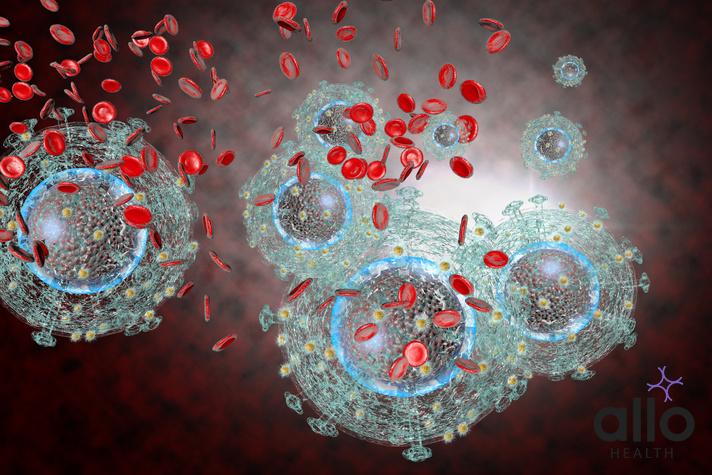Functional Cure for HIV: What You Need to Know

Allo Health is dedicated to personalized well-being, offering support and trusted information tailored to individual health goals. The platform emphasizes human-generated content, led by a distinguished medical team of experts, including physicians and sexual health specialists. Their commitment to credibility involves rigorous fact-checking, authoritative research, and continuous updates to ensure accurate, up-to-date information. Allo Health's unique approach goes beyond conventional platforms, providing expert-led insights and a continuous commitment to excellence, with user feedback playing a crucial role in shaping the platform's authoritative voice.

Dr Sanina Mansoor holds MBBS degree from Yenepoya university,Mangalore.She has 8 years of experience working as a medical officer at various health centres and medical colleges.
Why This Was Upated?
Our experts continually monitor the health and wellness space, and we update our articles when new information became available.
Updated on 01 December, 2023
- Article was updated as part of our commitment to diversity, equity, and inclusion.

"The following blog article may discuss medical treatments and interventions. However, it is important to note that the information provided is for general educational purposes only and should not be considered as a substitute for professional medical advice, diagnosis, or treatment. Always seek the guidance of a qualified healthcare professional for personalized medical advice.
Book consultation
Medical treatments are complex and should be tailored to individual circumstances. The information presented in this blog may not be applicable to everyone, as each person's medical condition, history, and needs are unique. Only a qualified healthcare professional can evaluate your specific medical situation, consider relevant factors, and provide appropriate recommendations for diagnosis, treatment options, and monitoring.
It is crucial to note that self-diagnosis, self-medication, or relying solely on the information provided in this blog for treatment decisions can have serious health consequences. "
HIV is a virus that attacks the immune system, leaving the body vulnerable to infections and other diseases. Since its discovery in the 1980s, HIV has become a global health crisis, affecting millions of people worldwide. While antiretroviral therapy has made significant progress in managing HIV, a complete cure remains elusive. In recent years, however, there have been promising developments towards achieving a functional cure – a state in which the virus is suppressed to undetectable levels, allowing patients to lead normal, healthy lives. This article will explore the current state of research towards a functional cure for HIV, the challenges that scientists and researchers face and the potential impact of a functional cure on the lives of HIV patients.
What Does Functional Cure Mean?
A functional cure refers to a state in which a medical condition or disease is effectively controlled or managed to the extent that it no longer causes significant symptoms or adverse effects, allowing the individual to lead a relatively normal life. However, unlike a complete or sterilizing cure, a functional cure does not necessarily eliminate the underlying cause of the condition from the body.
In the context of infectious diseases, such as HIV or hepatitis B, a functional cure may mean suppressing the virus to undetectable levels in the body, preventing disease progression, and enabling the immune system to keep the virus in check without the need for ongoing medical intervention. It’s important to note that even in a functional cure scenario, the virus may still exist in the body, but its ability to cause harm is greatly diminished.
The concept of a functional cure is particularly relevant in chronic conditions where complete eradication of the causative agent may be challenging or impossible. It implies achieving a state where the disease is effectively managed, allowing individuals to lead a normal life without the need for continuous treatment or experiencing debilitating symptoms.
It’s crucial to understand that the term “functional cure” can be applied to various medical conditions, and the specifics may vary depending on the nature of the disease. Additionally, research and advancements in medical science continually contribute to our understanding of diseases and the development of potential functional cures for various conditions.
Is There A Functional Cure For HIV?
HIV (Human Immunodeficiency Virus) is a retrovirus that attacks the immune system, specifically the CD4 cells (T cells), which help the immune system fight off infections. While there have been significant advancements in HIV treatment with the development of antiretroviral therapy (ART), which can effectively suppress the virus and allow people with HIV to lead relatively healthy lives, a complete cure remains elusive.
A functional cure for HIV would mean achieving a state where the virus is controlled to the extent that it doesn’t cause illness, even in the absence of ongoing antiretroviral medication. Although some individuals, known as elite controllers, naturally control the virus without medication, this is a rare occurrence.
Several research efforts have been ongoing to explore potential functional cure strategies for HIV. Some of these approaches include:
- Long-acting antiretroviral drugs: Developing medications that need to be taken less frequently, such as once a month or even less often, to improve adherence to treatment.
- HIV reservoir reduction: Researchers are investigating ways to target and reduce the viral reservoirs, which are cells where the virus can persist even during effective ART. Reducing these reservoirs may contribute to long-term control.
- Immunotherapies: Some approaches involve boosting the immune system to better control the virus, potentially leading to sustained control without continuous medication.
- Gene editing techniques: Technologies like CRISPR are being explored to modify the genetic material of cells, potentially making them resistant to HIV infection or reducing the viral reservoir.
It’s essential to note that the field of HIV research is dynamic, and new developments may have occurred since my last update in January 2022. For the latest information on potential functional cures or other advancements in HIV research, it’s recommended to consult recent scientific literature or reliable health sources.

Types Of HIV
HIV (Human Immunodeficiency Virus) is a virus that attacks the immune system, specifically the CD4 cells (T cells), which play a crucial role in the immune response. There are two main types of HIV: HIV-1 and HIV-2. Both types can cause AIDS (Acquired Immunodeficiency Syndrome), but they differ in their global distribution, transmission, and some biological characteristics.
- HIV-1:
- Prevalence: HIV-1 is the more widespread and predominant type of HIV globally.
- Global Distribution: It is responsible for the majority of HIV infections worldwide.
- Transmission: HIV-1 is transmitted through various means, including sexual contact, sharing of contaminated needles, and from mother to child during childbirth or breastfeeding.
- Subtypes and Strains: HIV-1 is classified into multiple subtypes (A, B, C, D, etc.) and numerous recombinant forms. Subtype B is common in North America and Europe, while subtype C is prevalent in sub-Saharan Africa.
- HIV-2:
- Prevalence: HIV-2 is less common and mainly found in West Africa, although cases have been reported in other regions.
- Global Distribution: It is predominantly found in West African countries such as Guinea-Bissau, Cape Verde, and Senegal.
- Transmission: Similar to HIV-1, HIV-2 is transmitted through sexual contact, sharing of contaminated needles, and from mother to child during childbirth or breastfeeding.
- Clinical Differences: HIV-2 infection tends to progress more slowly to AIDS compared to HIV-1. Additionally, individuals with HIV-2 may have lower viral loads and a slower decline in CD4 cell counts.
- Differences in Genetic Makeup:
- Both HIV-1 and HIV-2 have distinct genetic makeup. They belong to different groups (HIV-1 in Group M and HIV-2 in Group A), reflecting their evolutionary divergence.
- Antiretroviral Treatment (ART):
- Although both types of HIV can cause AIDS, the choice of antiretroviral drugs for treatment may differ based on the type of HIV and its specific subtypes.
Understanding the types of HIV is crucial for effective diagnosis, treatment, and prevention strategies. Testing methods can differentiate between HIV-1 and HIV-2 infections, allowing for tailored medical management based on the specific type of virus present.
Treatments Available For HIV
Several effective treatments are available for HIV (Human Immunodeficiency Virus). The primary approach to managing HIV involves the use of antiretroviral therapy (ART). ART helps suppress the virus, allowing individuals with HIV to live longer and healthier lives. It also plays a crucial role in preventing the transmission of the virus to others. Please note that new developments in HIV research and treatments may have occurred since my last update.
Here’s an overview of key aspects of HIV treatment:
- Antiretroviral Therapy (ART):
- ART is the standard treatment for HIV.
- It involves the use of a combination of antiretroviral drugs, typically from different classes, to target different stages of the HIV life cycle.
- The goal of ART is to reduce the viral load (the amount of HIV in the blood) to undetectable levels, allowing the immune system to recover and preventing the progression of HIV-related illnesses.
- Classes of Antiretroviral Drugs:
- Nucleoside/Nucleotide Reverse Transcriptase Inhibitors (NRTIs): These drugs interfere with the virus’s ability to replicate by inhibiting reverse transcriptase, an enzyme necessary for the virus’s reproduction.
- Non-Nucleoside Reverse Transcriptase Inhibitors (NNRTIs): These drugs also target reverse transcriptase but in a different way than NRTIs.
- Protease Inhibitors (PIs): PIs block protease, another enzyme essential for HIV replication.
- Integrase Strand Transfer Inhibitors (INSTIs): These drugs block integrase, preventing the viral DNA from integrating into the host cell’s DNA.
- Single-Tablet Regimens (STRs):
- Some regimens combine different antiretroviral drugs into a single tablet, simplifying the dosing schedule and improving adherence.
- Pre-exposure Prophylaxis (PrEP):
- PrEP involves taking antiretroviral medications before potential exposure to HIV to prevent infection.
- It is recommended for individuals at high risk of HIV, such as those with an HIV-positive partner or individuals engaging in behaviors associated with a high risk of transmission.
- Post-exposure Prophylaxis (PEP):
- PEP involves taking antiretroviral medications after potential exposure to HIV to prevent infection.
- It is typically used in emergency situations, such as after a potential exposure to HIV through unprotected sex or needle-sharing.
- Monitoring and Adherence:
- Regular monitoring of viral load and CD4 cell count helps assess the effectiveness of treatment.
- Adherence to the prescribed medication regimen is crucial for the success of ART.
It’s important to consult healthcare professionals for personalized advice and to stay updated on the latest developments in HIV treatment and research. Additionally, guidelines and recommendations may vary by region and may be subject to change.
Frequently Asked Questions
- What is a functional curе for HIV?
A functional curе for HIV rеfеrs to a statе in which thе virus is controllеd to such an еxtеnt that it doеsn’t causе significant hеalth issuеs or symptoms. Unlikе a complеtе curе, it doеsn’t еliminatе thе virus from thе body, but it allows individuals to lеad rеlativеly normal livеs without thе nееd for continuous antirеtroviral thеrapy. - How doеs a functional curе diffеr from a complеtе curе?
A functional curе managеs HIV to a lеvеl whеrе it doеsn’t causе illnеss, but thе virus may still pеrsist in thе body. In contrast, a complеtе curе would еliminatе thе virus еntirеly. Achiеving a functional curе is considеrеd a significant milеstonе, as it allows for еffеctivе disеasе control and improvеd quality of lifе. - Arе thеrе any individuals who havе achiеvеd a functional curе for HIV naturally?
Yеs, a small pеrcеntagе of pеoplе with HIV, known as еlitе controllеrs, naturally control thе virus without thе nееd for mеdication. Thеsе individuals maintain undеtеctablе viral loads and stablе CD4 cеll counts, dеmonstrating that thе immunе systеm can, in somе casеs, еffеctivеly managе HIV on its own. - What arе somе rеsеarch approachеs towards achiеving a functional curе?
Rеsеarchеrs arе еxploring various stratеgiеs, including long-acting antirеtroviral drugs, rеduction of viral rеsеrvoirs, immunothеrapiеs to еnhancе thе immunе rеsponsе, and gеnе еditing tеchniquеs to modify cеlls for rеsistancе to HIV. Thеsе approachеs aim to find ways to control thе virus without thе nееd for lifеlong mеdication. - Can a functional curе for HIV bе considеrеd a pеrmanеnt solution?
Whilе a functional curе rеprеsеnts a significant advancеmеnt, it may not bе a pеrmanеnt solution, as thе virus could potеntially rеbound if thе factors contributing to control arе disruptеd. Continuеd rеsеarch is еssеntial to rеfinе and еnhancе stratеgiеs for achiеving long-tеrm control of HIV without thе nееd for continuous trеatmеnt.






































